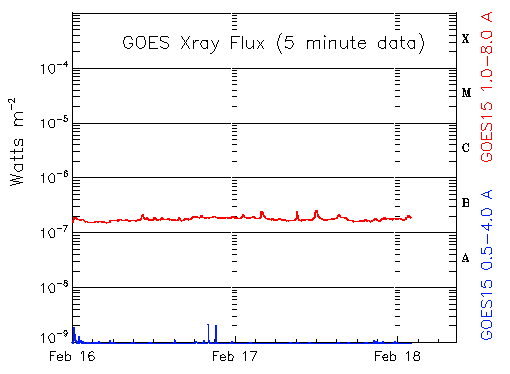Listen to radar echoes from satellites and meteors, live on listener-supported Space Weather Radio. | | |
SUNSET PLANETS: The brightest planets in the night sky are aligning for a must-see show in late February and March 2012. You can start looking tonight. [video] [full story].
QUIET SUN: Considering the fact that Solar Maximum is only about one year away, the sun is experiencing some remarkable spells of quiet. One of them is underway right now. There have been no significant flares for more than five days, and the sun's X-ray output has flatlined:

What's going on? In fact, solar activity is on the rise. For instance, an X-class solar flare on Jan. 27th triggered the strongest solar radiation storm since 2005. Also, auroras have been sighted recently as far south as Virginia and Oklahoma. The quiet interregnums are a sign that the current solar cycle, while active, is not quite as strong as other solar cycles that preceded it--like a mild hurricane season in the Gulf of Mexico. According to this point of view, temporary spells of low activity are to be expected. On the other hand, some researchers believe the quiet holds greater significance; it could foreshadow a major drop in solar activity. This is controversial, however, because forecasting the 11-year solar cycle is still an infant science. Indeed, surprises may be in the offing. Stay tuned for updates.
SPY-SAT DISAPPEARING TRICK: US spy satellite Lacrosse 5 occasionally confounds observers by disapppearing: In a matter of seconds, it can fade more than three astronomical magnitudes. Is this a deliberate form of stealth? Most experts think not, but no one outside of classified circles knows for sure what is going on.
To investigate, French astrophotographer Thierry Legault used his satellite-tracking telescope to photograph Lacrosse 5 as it sailed 490 miles above Paris on Jan. 15, 2012, and he caught the spysat in the act of disappearing:

"During the passage, the brightness of the satellite decreased by 10 times in only 4 seconds (a loss of 2.5 magnitudes)," describes Legault. "After 33 seconds of [dark flight] it regained its original brightness. Lacrosse 5 often shows this very singular behaviour, which is called by other observers (especially Marco Langbroek) the 'disappearing trick.'"
Other Lacrosse satellites do not perform the same trick, at least not to this extent, suggesting that the design of Lacrosse 5 differs from its predecessors. The fade is likely caused by some sort of self-shadowing--e.g., maybe some part of the spacecraft such as its solar panels casts a shadow over the main body when the spysat changes attitude.
Even Legault's fine images do not reveal the answer. "The cause of the disappearing trick, as well as the precise shape of the satellite, remain unknown."
Readers, would you like to try catching the tricks of Lacrosse 5? Check SpaceWeather's Simple Satellite Tracker and Flybys App for local flyby times.
January 2012 Aurora Gallery
[previous Januaries: 2010, 2009, 2008, 2007, 2005, 2004]
Comet Lovejoy Gallery
[previous comets: McNaught, Holmes, Lulin, Tuttle, Ikeya-Zhang]

